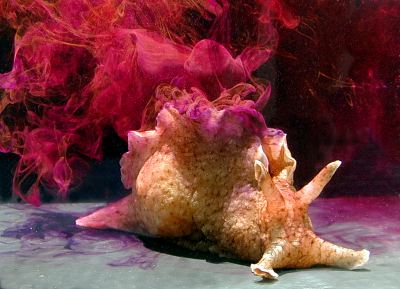Aplysia californica is a curious beast indeed. The California sea hare is a species of sea
slug; a hermaphroditic gastropod mollusc that feeds on seaweed and occasionally
squirts ink if you piss it off. Charming little chap, really.
A. Californica has become the best friend of the
neurobiologist. It is used extensively as a laboratory model in experiments looking
to elucidate how learning occurs, and how responses decline as a result of
repeated stimulation. What’s great about this animal is it elicits a
gill/siphon withdrawal response- a reflex which can be induced simply by
touching these parts of the animal’s body. This is brilliant for an
experimenter- this is a measurable, predictable, behavioural response, which
can be manipulated by different experimental conditions. Well done, California
sea hare.

While this animal has been essential in a huge amount of
neurobiological research, some of the most interesting hypotheses bourne-out of
research on the sea hare implicate prion proteins in memory and learning. This
is exciting, if a little controversial, because prions are often thought of
negatively- they are notorious in neurological disease.
Prions are proteins
which can take on at least two different conformations, one of which is
self-replicating. The self-replicating conformation often results
in protein aggregation and this can have unfortunate consequences when
inappropriate, in that it facilitates the transmission of often fatal neural
diseases such as Creutzfeldt-Jakob Disease (CJD). In CJD, a prion protein in
the brain becomes problematic if it acquires the self replicating conformation.
It begins to self replicate and aggregate, turning neural tissue in the brain
into what is, effectively, mush. A further, and more grizzly example comes from
‘kuru’, a disease which blights the ‘Fore’ tribespeople of Papua New Guinea,
and is transmitted by the practice of cultural cannibalism. Tribesmen eat the
brain tissue of the dead as a mark of respect, and hence, ingest the
self-replicating prion which causes neurological degeneration and contract the
‘kuru’ disease themselves.
Prions can self-replicate because the protein
in the self-replicating conformation can act as a template to encourage other
prions to take on its shape. In turn,
these act as templates form more prions, and a chain reaction is triggered. The
ability to self-replicate their conformation also allows prions to transmit
information, meaning they may be important in cellular memory. Perhaps most
controversially, prion-like proteins have been implicated with long term
neuronal memory, and this is where our friend the sea slug comes in.
‘CPEBs’ are vital proteins
which are conserved across species and bind specifically to short lengths of 3’
RNA. They are involved in activating mRNAs which are transcriptionally silent
via polyadenylation / altering the cellular localization of the mRNA, and are
hence referred to as ‘cytoplasmic polyadenylation elements’ (CPEs). ApCPEB is a
specific type of the CPEB protein which carries an N-terminal domain that is
rich in glutamine residues. These are uncharged, polar amino acids, so this
domain promotes protein aggregation in a prion-like manner. A neuronal form of
this protein is present in the sea slug Aplysia
californica, and this regulates the transcription of genes important for
synaptic growth and function. In fact, the translation of ApCPEB from mRNA in
neurons is activated by the neurotransmitter serotonin.
Some studies suggest that this protein may be
involved in neuronal memory, because when repressed, long-term facilitation is
blocked in A. californica. In the
wild type condition, if the gills are repeatedly touched, inducing the
aforementioned withdrawal response, the animal will habituate. This means its
withdrawal response will become less and less intense as the gills are touched
more and more often. This indicates that the animal is becoming ‘used to’ the
touch, is becoming familiar with the stimulation, and is perhaps ‘learning’
that no significant consequences come about from it. One study showed that the
absence of functional ApCPEB in the animal lead to decreased habituation to
repeated touching of the gills. Withdrawal response intensity did not decrease,
suggesting the animal’s ability to learn and become familiar with the
stimulation was inhibited. Specifically, it may be the prion-like conformation
of ApCPEB that allows this associative memory, as it seems that the aggregated,
prion-like form of ApCPEB is the one which is induced when synapses are
stimulated.
What is intriguing about
implicating prions in long-term memory is that they provide a solution for how
information can be stored at a biochemical level despite the fact that proteins
are continuously turning over. While
transcriptional feedback loops provide an alternative explanation for possible
mechanisms of ‘memory’, the prion explanation might be that these proteins
store information despite being continuously made and degraded by forcing other
prions into the self-replicating conformation, and so information is preserved.
While this is interesting, it
is still controversial, and is far from being an established possibility.
Undoubtedly, there are still many more questions to be answered about how we
and other species are able to learn and remember, and perhaps the California sea
hare will be of great aid in answering such questions in years to come.
Citation: Shorter, J&Lindquist, S; 'Prions as adaptive conduits of memory and inheritence'. Nature reviews genetics (2005).


